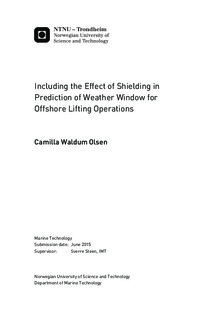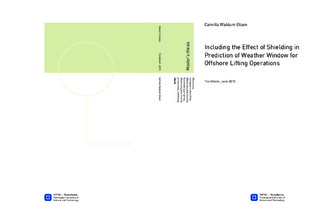| dc.description.abstract | The offshore industry is constantly seeking to operate in more extreme conditions. DeepOcean is a subsea service company, where offshore lifts is a part of every day operations. To remain competitive, it is important to reduce operational downtime, where time spent waiting on weather is one of the main contributors. The main goal of this thesis is to investigate how shielding effects influence the operational limit for offshore lifting operations at different heading angles. Common practice in the offshore industry is to use long-crested waves when determining the operational limit, and shielding effects are often neglected, which is a conservative approach.
A case study of two different structures, a Manifold and a ROV system, has been conducted. Repeated launch and recovery analyzes has been performed in Orcaflex, a time domain finite element program developed for static and dynamic analysis of offshore systems. Irregular waves are applied using a JONSWAP spectrum with $T_{p}=5-19 s $ and $H_{s}=1-4 m$ for the Manifold and $H_{s}=2-8 m$ for the ROV system. Both long- and short-crested waves, as well as 4 heading angles have been investigated. Shielding effects has been accounted for by the use of Sea State RAOs calculated in WADAM, a hydrodynamic analysis program for calculation of wave-structure interaction. The maximum tension in the lifting wire is considered as the dimensioning parameter. Gumbel extreme value statistics has been used to evaluate the distribution of maximum lifting wire tension, based on 20 simulations per sea state.
The calculated maximum wire tension was found to be highly dependent on whether or not slack would occur during a simulation. A slack wire result in snap loads with unpredictable magnitude. Incorporation of shielding in the simulations resulted in a significant drop in the occurrence of slack, for both structures. Thus, shielding effects is found to reduce the uncertainty related to the maximum tension due to a reduction in snap loads. The operational limit for the Manifold was increased with 0.5-1.0 m on average when shielding was included for most periods and heading angles, for both long-and short crested waves. The results obtained for the ROV was found to be highly unpredictable in magnitude due to slack occurring in the dominating part of the simulations, especially for steep waves. In contrast shielding showed to have a consistent positive effect, for heading angles with low vessel motion in roll. | |

